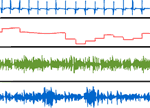Mixed Sleep Apnea
Causes, Symptoms and Treatments for Mixed Sleep Apnea

Mixed sleep apnea is a combination between obstructive (absence of airflow but continued respiratory effort) and central (absence of airflow and respiratory effort).
It starts typically with central apnea episodes for about 10 seconds, followed by obstructive apnea events.
A majority of patients with obstructive sleep apnea (OSA) have both obstructive and central apneas.
How to Diagnose Mixed Apnea
Mixed Apnea vs Complex Apnea
There is a common misunderstanding relating to the diagnosis of mixed apnea. Many people confuse the term complex sleep apnea with mixed apnea, although they represent different thing.
Complex apnea is diagnosed in a sleep study if you:
- have obstructive sleep apnea
- the CPAP or BiPAP machine removes the OSA, but...
- central sleep apnea shows up once the obstructive apnea is treated with breathing machines.
In other words, complex apnea is a form of sleep apnea where central apneas persist or emerge while attempting to treat obstructive events with a CPAP device.
However, mixed sleep apnea is diagnosed in a sleep study if you:
- have obstructive sleep apnea, with an apnea hyponea index AHI greater than 5,
- and you also have central sleep apnea, with AHI greater than 5.
Even so, it's pretty common to have central apnea when you the start sleep apnea treatment, so usually the central events are ignored in your early sleep studies when they start out.
In other words, the sleep doctor will not normally score the central events which are a result of moving during sleep or sleep transitions. But if those central apneas persist, then doctors may consider you have mixed apnea.
Causes of Mixed Sleep Apnea
The cause of mixed apnea is uncertain, but it can appear when the airway closes during a central sleep apnea episode.
In other words, if an obstructive episode happens during a central apnea episode, then you have mixed apnea.
However, mixed apnea can appear due to breathing efforts from obstructive episodes. Here is an explanation of this phenomenon:
- After a long pause in breathing in your sleep, the blood oxygen level will be low. You will have gasps and other breathing efforts to recover your oxygen level.
- From this breathing effort results an unusually high level of carbon dioxide in the blood, which may trigger a central apnea event.
- The harder the event of obstructive sleep apnea, the more likely is expected a central apnea event to appear. In this situation, we have mixed apnea.
- Regarding the treatment for this type of mixed apnea, it's obvious that when you treat obstructive apnea, the "overbreathing" event will disappear. Central apnea is less likely to appear in this situation, so mixed apnea event will disappear as well.
Treatment of Mixed Sleep Apnea
Because mixed apnea usually starts with a central apnea episode followed by obstructive events, you will need a more complex breathing machine than a simple CPAP.
At this time, the best therapy for mixed sleep apnea is VPAP Adapt SV, which is a breathing machine that uses adaptive servo-ventilation to adapt to your respiratory needs every time you want to inhale, exhale or if you stop breathing.
The VPAP Adapt SV is a very complex machine, which can treat not only mixed apneas, but also complex apnea, central apnea and Cheyne-Stokes respiration.







